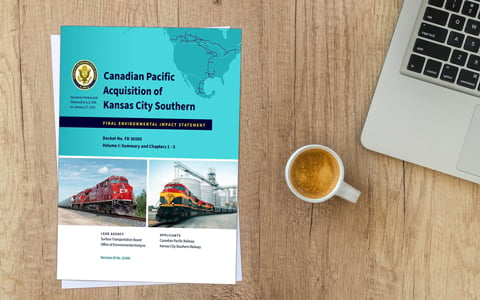
The U.S. Surface Transportation Board (Board) approved the $31 billion merger of two major North American railway companies—Canadian Pacific Railway (CP) and Kansas City Southern (KCS)—this spring, creating the first railroad connecting Canada, the United States, and Mexico. The merging of CP and KCS will establish a rail network of more than 22,000 miles, which is intended to produce a more direct and efficient route for goods to travel.
As part of the review process, the Board selected VHB to support navigation of the Environmental Impact Statement (EIS) process under the National Environmental Policy Act (NEPA). This support also involved developing strategies and tactics to comply with the National Historic Preservation Act process and other statutes, regulations, and Executive Orders. VHB’s environmental, cultural resources, rail operations, and traffic operations and safety teams evaluated potentially adverse effects of the merger due to the increased rail activity anticipated primarily between Chicago, IL, and Laredo, TX.
“VHB recognizes the original and ongoing intent of NEPA to prepare concise, timely environmental reviews that are useful to decisionmakers and the public,” said Alan Summerville, the Project Manager for the EIS and VHB’s NEPA Practice Leader. “In keeping with that intent, VHB supported the Board’s preparation of a Draft EIS in approximately 10 months and a Final EIS in three months after responding to approximately 700 comments. The body of the EIS, excluding appendices, is approximately 300 pages as required by regulation.”
The evaluation comprised freight and passenger rail safety (including the transportation of hazardous materials), safety analysis at 1,270 highway/rail grade crossings, potential delays at grade crossings, noise and vibration, air quality and climate change, energy consumption and commodity movements, impacts to historic structures and archaeological sites, and whether the merger would result in disproportionate impacts to minority or low-income populations. VHB conducted water, natural, and cultural resources surveys and analyses on 25 proposed sidings, siding extensions, or double tracks from Illinois to Louisiana.
The EIS process and Environmental Justice process included a massive outreach effort to potentially affected communities, including local, state, federal, and tribal officials, as well as potentially interested organizations. The team reached the public in a variety of ways: meetings with elected officials and representatives of Environmental Justice communities, letters and email, google ad banners, press releases to local media, postcards, phone calls, a website, and public comment periods. In addition, four in-person meetings and three online public meetings were held to review and comment on the Draft EIS. The agency consultation effort was extensive. For example, VHB supported consultations with eight State Historic Preservation Offices from Illinois to Texas and numerous tribes to reach findings of no adverse effect.
“That is an incredible feat for a project of this size and on this schedule,” said Alan. “VHB approaches these reviews as much more than the preparation of a document. EISs are a product that results from a complex process involving agency consultation, public involvement, the development of a reasonable range of alternatives, and a focus on what is important to provide compliance with numerous regulations and Executive Orders, as well as developing mitigation.”
Learn more about VHB’s environmental and cultural resources services on our website or contact Alan Summerville to learn more about this project.


